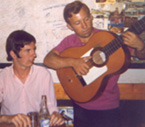Welcome to one of the most active flamenco sites on the Internet. Guests can read most posts but if you want to participate click here to register.
This site is dedicated to the memory of Paco de Lucía, Ron Mitchell, Guy Williams, Linda Elvira, Philip John Lee, Craig Eros, Ben Woods, David Serva and Tom Blackshear who went ahead of us.
We receive 12,200 visitors a month from 200 countries and 1.7 million page impressions a year. To advertise on this site please contact us.
|

|
|
Ritmo
|
You are logged in as Guest
|
|
Users viewing this topic: none
|
|
Login  | |
|

   
Miguel de Maria
Posts: 3532
Joined: Oct. 20 2003
From: Phoenix, AZ

|
 Ritmo Ritmo
|
|
|
Look, I'm a guitarist, I can admit that rhythm is probably my weakest area. Besides stage moves, I never got that down! I recently bought a book called "Modern REading text in 4/4", subtitled Syncopation Studies Designed to Develop Accuracy and Speed in Sight Reading.
This book is aimed at the speed reader, presumably the jazz or orchestral player who needs to be able to play things through right, the first time. It basically takes all the tricky little parts you might find once in awhile and compiles pages of them!
Now... I have been working through this stuff, a littlle here and little there, with the metronome, tapping with a pencil or hitting the bongo, or playign various things on the guitar, along with these syncopation studies, to great effect. Not only have I gotten better at playing through the studies, but I have found myself recognizing and identifying the patterns in music I hear, both from Cds and in my head. The benefits of this hardly have to be mentioned.
When I took a workshop from Maria Temo from DC, she wrote some numbers on the board. 12 3 6 8 10 was one, 12 2 4 6 8 10, was another, 12 3 6 9, and 1-2 4-5 7-8 10-11 the last. She said that almost all 12-count falsetas are based on these accents.
Hmmm, now how do these disparate events relate? Well, I'm not sure. But flamenco and all music is made up of a vocabulary of rhythmic, melodic, and harmonic "words". By studying these "words" individually and mastering them, you will have set the foundation for learning phrases and in the idiom. Maybe this all sounds commonsensical, but it is often ignored. A student will try to learn a whole falseta and play it through dozens of times in his quest to learn it. A better way would be to examine it beat by beat and make sure he understands the rhythmic implications of each beat.
This sounds daunting, but if you slow it down, it can be done. Try it with easier pieces at first--I'm working on a didactic falseta by Manuel Granados, and one compas has beats with 3, 6, 8, and 7 notes in them! A (eight note, two sixteenth note), a (6 sextuplets arpeggio), a (8 32nd note run), a (6 sextuplets run), and a (7 septulets [is that a word?]) run. To try to play this compas through without making sure you have each beat mastered would be an exercise in futility. of course this is a somewhat extreme case, a slow, expressive soleares.
I suggest to everyone, get an elementary book on percussion/drums and practice your beats and your syncopations. Think how much easier learning a falseta would be, when if you hear a run or an arpeggio, you instantly realize how many notes is in each beat. This is very possible and in fact quite easy with a little bit of practice. And break down your falsetas, don't rely on the 'Inner Diety of Guitar' to magically guide your fingers.
|
|
|
|
REPORT THIS POST AS INAPPROPRIATE |
Date Apr. 27 2004 22:24:34
 |
|
 New Messages New Messages |
 No New Messages No New Messages |
 Hot Topic w/ New Messages Hot Topic w/ New Messages |
 Hot Topic w/o New Messages Hot Topic w/o New Messages |
 Locked w/ New Messages Locked w/ New Messages |
 Locked w/o New Messages Locked w/o New Messages |
|
 Post New Thread
Post New Thread
 Reply to Message
Reply to Message
 Post New Poll
Post New Poll
 Submit Vote
Submit Vote
 Delete My Own Post
Delete My Own Post
 Delete My Own Thread
Delete My Own Thread
 Rate Posts
Rate Posts
|
|
|
Forum Software powered by ASP Playground Advanced Edition 2.0.5
Copyright © 2000 - 2003 ASPPlayground.NET |
0.046875 secs.
|


 Printable Version
Printable Version








 New Messages
New Messages No New Messages
No New Messages Hot Topic w/ New Messages
Hot Topic w/ New Messages Hot Topic w/o New Messages
Hot Topic w/o New Messages Locked w/ New Messages
Locked w/ New Messages Locked w/o New Messages
Locked w/o New Messages Post New Thread
Post New Thread